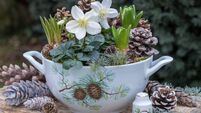Helluva great plant

Since modern medicine took us, mostly beyond the reach of herbal remedies, no one much bothers anymore with the history of plants. I am concerned therefore that most, if not all, the ancient oral associations will be lost; the stories that have gathered around plants from one generation to the next, and more importantly, their uses in homeopathic medicine. I feel it is imperative to know something of the history of what we grow, at least as a courtesy. So let me redress the situation now and tell you something of the extraordinary uses that garden plants were put to long, long ago.
I’m in favour of, and depend on, the use of modern medicine but was there really any harm in adding a few fresh leaves of wild garlic (Allium ursinum) to a salad in order to help digestive problems, rheumatism, high blood pressure and asthma? Or using Old Man’s Beard (Clematis vitalba) in homeopathy to treat skin rashes, swollen glands, rheumatism, and male sexual disorders? During the Middle Ages if cattle fell sick, farmers used to bore a hole through the animal’s ear and insert a piece of Hellebore root. The practice was still popular in the 17th century as evidenced in herbalist John Gerard’s writings: ‘A purgation of Hellebore is good for mad and furious men, for dull and heavie persons, and briefly, for all those that are troubled with black choler and molested with melancholy’. I study these lines with a mixture of awe and terror.!
Today however, we grow Hellebores for ornamental purposes, never medicinal.
But if you have yet to meet with these upper class beauties then let me tell you of one of their many virtues and their only vice. Their greatest virtue is early flowering in a range of colours which are hard to describe. It is like the spectrum for shades of fine wine, from a white that is yellowy green to deep claret red and all the colours and mixtures between the two. Their only vice is a nasty virus which leads to distortion and stunting of the plant, even death in severe cases.! Commonly called Hellebore ‘black death’ classic symptoms include black veins along leaves stems and flowers. Affected specimens should be dug up and destroyed for there is no cure.
Aphids are thought to spread the virus so check buds and shoots during mild spells in spring and rub these off before they multiply. Hellebores with solid black blotches are more likely to be suffering from hellebore leaf spot, in poor, perhaps waterlogged growing conditions. Cut off older infected leaves and improve drainage by incorporating grit into the soil.
Young plants bought and set in position this spring could take all of three years before they really flower in character. Encourage them by watering well in dry periods this summer, and bear in mind that they resent disturbance. As long as they are given rich and moist soil, and never allowed go hungry they will give decades of pleasure.













